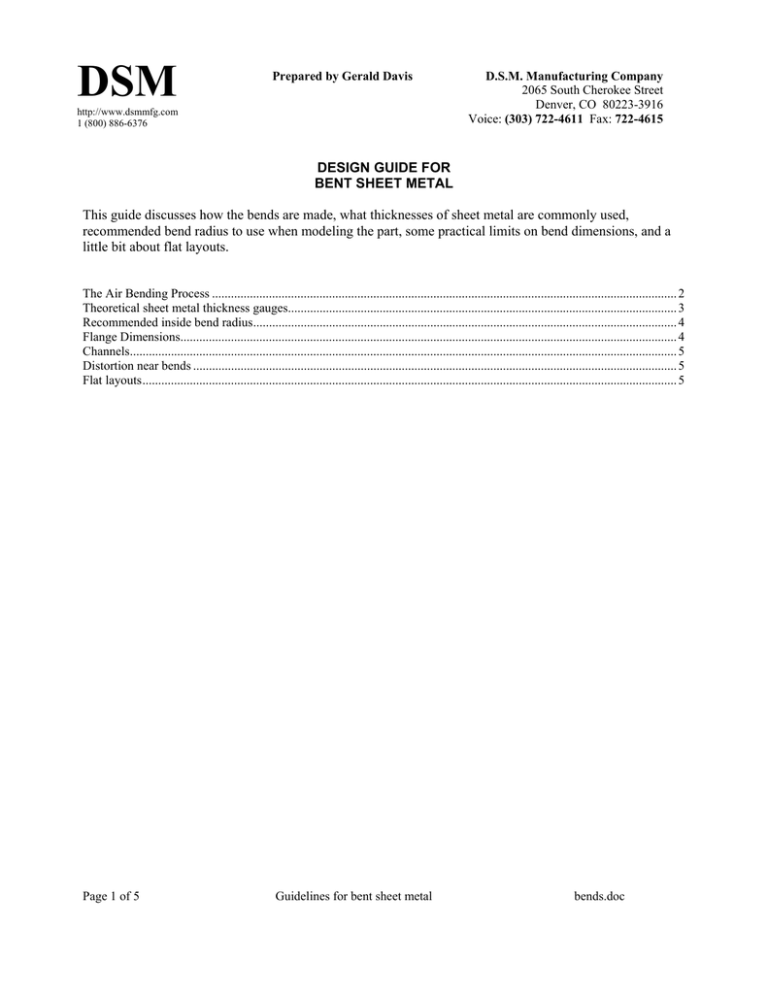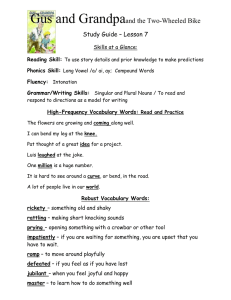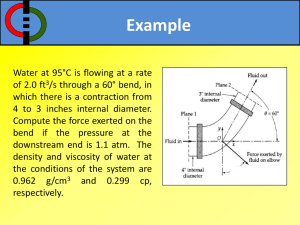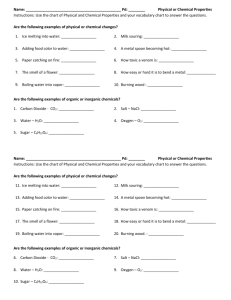DESIGN GUIDE FOR BENT SHEET METAL This guide discusses
advertisement

DSM Prepared by Gerald Davis http://www.dsmmfg.com 1 (800) 886-6376 D.S.M. Manufacturing Company 2065 South Cherokee Street Denver, CO 80223-3916 Voice: (303) 722-4611 Fax: 722-4615 DESIGN GUIDE FOR BENT SHEET METAL This guide discusses how the bends are made, what thicknesses of sheet metal are commonly used, recommended bend radius to use when modeling the part, some practical limits on bend dimensions, and a little bit about flat layouts. The Air Bending Process ................................................................................................................................................... 2 Theoretical sheet metal thickness gauges........................................................................................................................... 3 Recommended inside bend radius...................................................................................................................................... 4 Flange Dimensions............................................................................................................................................................. 4 Channels............................................................................................................................................................................. 5 Distortion near bends ......................................................................................................................................................... 5 Flat layouts......................................................................................................................................................................... 5 Page 1 of 5 Guidelines for bent sheet metal bends.doc DSM Prepared by Gerald Davis http://www.dsmmfg.com 1 (800) 886-6376 D.S.M. Manufacturing Company 2065 South Cherokee Street Denver, CO 80223-3916 Voice: (303) 722-4611 Fax: 722-4615 The Air Bending Process In the diagram to the right, we see a cross section view of a piece of sheet metal that is in the process of being bent. There are also 2 components of the tooling shown in this figure; the upper tool (or punch) is pressing down on the sheet metal at the center of the bend while the lower tool (or vee die) is pressing up on the sheet metal. In general, the tooling only touches the sheet metal along these 3 lines. Thus the process is call “air bending”. If the punch and the die are firmly pressed against the sheet metal to force it to conform to the shape of the punch tip and die, that is referred to as “coining” or “bottom bending”, depending on how much pressure is applied. The main advantage of the air bending process is that it is versatile and not entirely dependent upon the tooling. That is, the same bend can be made with several combinations of upper and lower tooling. The inside bend radius that is developed during the air bending process depends on 3 factors: 1) the width of the vee die, 2) the stiffness of the material, and 3) the radius of the upper tool. The wider the vee die, the larger the resulting bend radius. The more ductile (easier to bend) the material, the smaller the resulting bend radius. If the upper tool’s radius is large enough, it will override the preceding 2 factors. Page 2 of 5 Guidelines for bent sheet metal bends.doc DSM Prepared by Gerald Davis http://www.dsmmfg.com 1 (800) 886-6376 D.S.M. Manufacturing Company 2065 South Cherokee Street Denver, CO 80223-3916 Voice: (303) 722-4611 Fax: 722-4615 Theoretical sheet metal thickness gauges The emphasis on theoretical is due to the fact that most rolling mills (manufacturers of sheet metal) will maximize the square footage and minimize the thickness. The actual thickness will be about 95% of the nominal theoretical gauge. Note that nonferrous gages (aluminum) ARE NOT the same as ferrous gages (steel & stainless)! It is common practice to specify the aluminum simply in the decimal thickness (no gage). For example, “MATERIAL: .100 5052-H32 ALUMINUM”. Steel and stainless steel are frequently specified by gauge and decimal thickness. For example, “MATERIAL: 16 GA (.059) COLD ROLL STEEL”. ALUMINUM / BRASS/ COPPER (mm) (inches) 5.18 .190 4.11 .160 3.66 .144 3.26 .125 2.58 .100 2.30 .090 2.05 .080 1.82 .072 1.68 .062 1.29 .050 1.02 .040 0.81 .032 0.64 .025 0.51 .020 0.40 .016 0.32 .012 Gage 4 6 7 8 10 11 12 13 14 16 18 20 22 24 26 28 STEEL / STAINLESS (inches) (mm) .224 5.69 .194 4.93 4.55 .179 .164 4.17 3.41 .134 3.03 .119 2.65 .104 2.27 .090 1.89 .074 1.51 .059 1.21 .047 0.91 .035 0.75 .030 0.60 .024 0.45 .017 0.37 .015 There are other gauges than those listed in this table, but these are the ones that are commonly available. Page 3 of 5 Guidelines for bent sheet metal bends.doc DSM Prepared by Gerald Davis http://www.dsmmfg.com 1 (800) 886-6376 D.S.M. Manufacturing Company 2065 South Cherokee Street Denver, CO 80223-3916 Voice: (303) 722-4611 Fax: 722-4615 Recommended inside bend radius A general guideline is to keep the inside radius approximately equal to the material thickness. The following tables reflect actual experience with the tooling shown. In some cases, a smaller radius can be used (consult with one of our Project Managers for further detail). Aluminum (5052 or 3003*) Thick Developed Vee Inside Bend Die Radius Width 1.260 .190 .203 .984 .160 .156 .709 .125 .125 .630 .100 .109 .554 .090 .094 .472 .080 .078 .394 .062 .047 .276 .050 .047 .236 .040 .031 .157 .032 .031 Steel or Stainless Steel Thick Developed Inside Bend Radius 7 GA (.179) .203 10 GA (.134) .156 11 GA (.119) .125 12 GA (.104) .109 13 GA (.090) .094 14 GA (.074) .078 16 GA (.059) .047 18 GA (.047) .047 20 GA (.035) .031 22 GA (.030) .031 24 GA (.024) .020 Vee Die Width 1.260 .984 .709 .630 .554 .472 .394 .276 .236 .157 .157 *For 6061 aluminum, the minimum inside bend radius should be 6X the material thickness, otherwise cracking is likely to occur during forming. Flange Dimensions To be clear about what we’re talking about, let’s make a distinction between the length of the bend and the length of the flange. The bend length is the horizontal length of the bend. The longer the bend, the more material is being bent, and the more pressure it takes to make the bend. The flange length is the distance from the bend to the edge of the part (or to another bend). Since the flange must bridge across the vee die, it must be longer than ½ of the vee die opening. In general, the flange length should be at least 4X the material thickness (as measured from the outside of the bend). It is possible to produce shorter flanges, but the process will probably require extra expense. Page 4 of 5 Guidelines for bent sheet metal bends.doc DSM Prepared by Gerald Davis http://www.dsmmfg.com 1 (800) 886-6376 D.S.M. Manufacturing Company 2065 South Cherokee Street Denver, CO 80223-3916 Voice: (303) 722-4611 Fax: 722-4615 Channels “U” channels that have the leg dimension equal to (or greater than) the base dimension are generally safe. As the base dimension gets narrower, the need for special tooling is likely to appear. Please contact one of our Project Managers for advice and further detail. Distortion near bends Holes (or cutouts) that are too close to the bend will distort during the bending process. If you keep the distance from the edge of the hole (or cutout) to the start of the inside bend radius at least 2X the material thickness, the distortion will be minimal. Flat layouts Before the sheet metal is bent, it is in the “flat layout” condition. Experts in the sheet metal trade can predict how the sheet metal will behave as it is bent and adjust the flat layout so that the resulting part matches the mechanical drawing specification. In general, sheet metal stretches when it is bent. For example, if you were to take a piece of metal that measured exactly 2.000” in the flat and then bent it down the middle at 90°, when you measure the length of the 2 bends (from the outside of the bend), the sum of the leg lengths would be greater than 2.000” (in the case of 16 GA (.059) cold roll steel, it would be likely to add up to 2.094”). “Bend deductions” predict how much the material will stretch when it is bent. The bend deduction depends upon the material thickness, the bend radius, and the bend angle. Each sheet metal shop has its own set of proprietary bend deductions. This is generally not something that the designer need worry about. However, if you want to experiment with flat layouts in a CAD system, we recommend using the KFactor (also known as neutral line) layout method. The K-factor is primarily dependent upon the material stiffness. To a lesser extent, it is effected by the bend radius. • For aluminum, use a K-Factor of .4850 • For steel, use a K-Factor of .4800 • For stainless steel, use a K-Factor of .3900 These recommendations are not “exact”, but the will get you very close (usually within .020”) of a good flat layout. If you’d like to have a more complete and detailed table for K-Factors, contact one of our Project Managers. Page 5 of 5 Guidelines for bent sheet metal bends.doc



